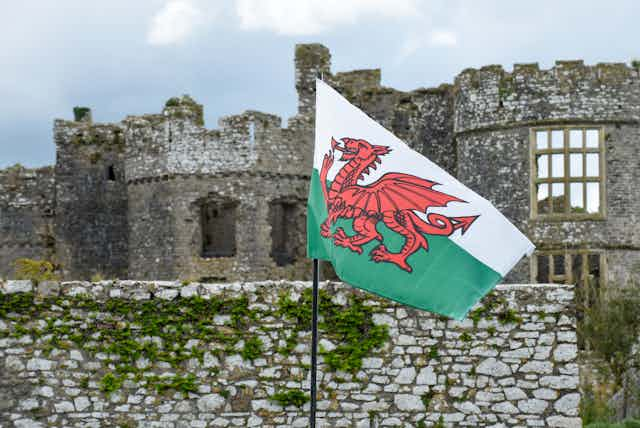Amid the rush to erect historical and national memorials in late 19th century Europe, huge commemorations in honour of figures and events in the past were built. In England, public commemoration went through something of a golden age. A love of anything medieval and the cult of heroism, where great historical figures were revered for their achievements, created the perfect opportunity for a nationalistic commemorative boom.
Parks filled up with statues of the great men of history, and the death of Prince Albert and the jubilee of Queen Victoria kept sculptors busy. Scotland gained the National Wallace Memorial in 1869, and a statue of Robert the Bruce ten years later, both commemorating Scotland’s history as an independent nation. In Wales, memorials for churchmen and industrialists sprang up, but the one thing Wales lacked was a national memorial to its history as an independent country.
In the 1890s, there was a sudden wave of interest in commemorating Llywelyn ap Gruffudd (1223-1282,) the last independent Welsh prince before the conquest of Wales by England’s Edward I. At the start of 1895, a group of the great and good met to organise their new Llywelyn memorial committee. It planned to raise funds and organise the commemoration of the prince. They decided on a public appeal, confident that the growth of nationalism seen across Europe had something to teach Wales.
By spring, enthusiasm was growing. The committee members commissioned Welsh poet Sir Lewis Morris to compose a poem and distributed 5,000 free copies to drum up interest. But just as it looked like plans for commemoration would work out, things started to go wrong.
The Western Mail, the largest daily newspaper in Wales, attacked the “memorial movement” for achieving little, and claimed that people were already going lukewarm on the idea. It was “nothing short of a national disgrace”, they claimed, and greater efforts needed to be made.
Ask the public
The committee decided to organise visits to large groups of potential donors like the quarry-men of Ffestiniog and townspeople of Aberystwyth. “Llywelyn Saturday” was proposed as a special fundraising day to raise awareness of the committee’s aims.

They also asked the public where to build the memorial, and gave them the power to decide how and where their donation should be spent. The idea of asking for thousands of small donations was aimed at giving Welshmen a voice, but it was also considered the best way to raise funds from the masses in a country where those interested in the memorial had very little cash.
After months of confusion, subscribers were asked to choose one of three sites for the memorial with their donation going to their preferred place: where Llywelyn was buried at Abbey Cwmhir, where he was killed outside Builth Wells, or an unspecified place in north Wales because he had been the ruler of Gwynedd.
Giving people a choice was admirable but completely impractical. Aside from the fact that the funds raised would be split across at least three sites, the committee had put no thought into the feasibility of their plans. Where in north Wales would be suitable? Was Llywelyn actually buried at Abbey Cwmhir? And if he was, had they asked the landowner if they could build on his land? (No, they had not).
Another popular idea among the committee was Cardiff, though this was not put to subscribers. Cardiff was not yet the Welsh capital but it was the largest urban area in the country. The memorial would be seen by a lot of people there, and visitors from England were considered more likely to know about it.
Even if a site could be chosen, the form of the memorial could not. The Marquis of Bute opposed a statue on the basis that no one knew what Llywelyn had looked like. That hardly stopped sculptors of other historical figures. Other options proposed were an obelisk or pillar, a “colossal cross”, or a simple tomb. As with the location, no one could decide.
Abandoned plans
In 1898, the closure of the committee was announced. No national memorial had been built. But the idea wasn’t quite dead.

That year, a colourful statue of Llywelyn was erected atop a drinking fountain in Conwy. Though this was not to commemorate Wales’ era of independence, but the arrival of the town’s municipal water supply.
In 1902, local landowner Stanley Bligh paid for an obelisk to be built at the place of Llywelyn’s death (which was replaced in 1956). And during the first world war, Llywelyn was memorialised in the Cardiff City Hall alongside other Welsh figures in its Marble Hall, the “Valhalla for Wales”. None of these though was a national and public memorial.
Being unable to agree on a united national memorial shows just how disunited Wales had been, and still was. After all, Llywelyn had been briefly recognised as Prince of Wales, but never actually ruled a united country. The failure of a truly national memorial to the prince as a symbol of Wales’ independent past was perhaps the most fitting memorial of all.

Looking for something good? Cut through the noise with a carefully curated selection of the latest releases, live events and exhibitions, straight to your inbox every fortnight, on Fridays. Sign up here.

